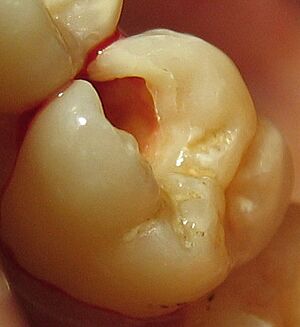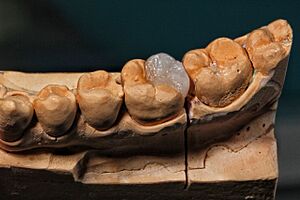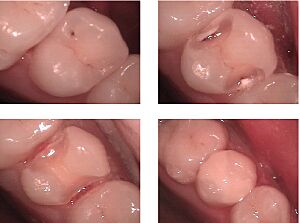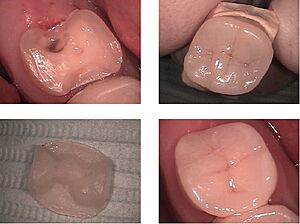Dental restoration facts for kids
A dental restoration, often called a dental filling or just a filling, is a treatment used by dentists to fix a tooth that has lost some of its structure. This can happen because of tooth decay (cavities) or an injury. Fillings help bring the tooth back to its normal shape, strength, and function. They can also be used to replace missing tooth structure supported by dental implants.
There are two main types of fillings: direct and indirect. They are also grouped by where they are placed in the mouth and how big they are. For example, Root canal therapy is a special type of restoration that fills the space inside the tooth where the dental pulp (nerve and blood vessels) used to be.
Contents
A Look Back: History of Fillings
People have been trying to fix teeth for a very long time! In Italy, about 13,000 years ago, there's proof that a sticky substance called bitumen was used to fill a tooth. In Slovenia, about 6,500 years ago, beeswax was used to fix a broken tooth. Ancient Roman writers, like Pliny the Elder, even wrote about materials used to fill hollow teeth.
Getting Your Tooth Ready for a Filling
Fixing a tooth so it works well again involves two main steps:
- First, the dentist prepares the tooth for the filling material.
- Second, the dentist places the filling material.
Preparing the tooth usually means carefully removing any decay or weak parts of the tooth. This is often done using a special drill, a dental laser, or a method called air abrasion. Sometimes, if a permanent filling can't be done right away, a temporary restoration might be placed.
Once the tooth is prepared, it's called a tooth preparation. The materials used for fillings can include gold, amalgam, dental composites, glass ionomer cement, or porcelain.
The way a tooth is prepared depends on several things. The most important factor is how much decay there is. The amount of decay usually decides how much of the tooth needs to be removed and what kind of filling will work best.
Another important thing is making sure the remaining tooth structure is strong. The outer layer of your tooth, called enamel, is very hard but can break easily if it's not supported. So, dentists remove any unsupported enamel to make the filling last longer.
For baby teeth, some studies suggest that putting a metal crown over the tooth (called the Hall technique) or only partly removing decay before filling might be better than removing all decay. For adult teeth, partially removing decay or doing it in two stages might also be better than removing all decay at once.
Direct Fillings: Done in One Visit
With direct fillings, the dentist places a soft or moldable material directly into the prepared tooth. They then shape it to fit your tooth perfectly. This material then hardens, and your tooth is restored. If a side of the tooth is missing, the dentist might use a special band called a matrix to help rebuild the tooth's shape. This helps make sure the tooth is easy to clean and doesn't stick to the next tooth.
The great thing about direct fillings is that they usually harden quickly and can be done in a single visit. Dentists have different materials to choose from, depending on where the cavity is and how big it is. Since the material hardens while it's in your mouth, only a small amount of heat reaches your tooth.
Indirect Fillings: Made Outside the Mouth
Indirect fillings are made outside your mouth. First, the dentist takes a mold (an impression) of your prepared tooth. Then, a dental technician uses this mold to create the custom filling, like an inlay, crown, bridge, or veneer. These are often made from gold or ceramics.
Once the indirect filling is ready, usually after a second visit, the dentist permanently glues it onto your tooth using dental cement. While you wait for your permanent indirect filling, you might get a temporary restoration to protect your tooth.
Sometimes, removable dental appliances like dentures are also considered indirect restorations because they replace missing teeth.
A cool way to make indirect fillings is using the CEREC method. The dentist takes a digital picture of your tooth with a special camera. A computer then turns this picture into a 3D model. A machine then carves the filling out of a ceramic block that matches your tooth color. This all-ceramic filling is then ready to be bonded to your tooth, often in the same visit!
How Dentists Classify Cavities
Dentists use different ways to classify cavities, which helps them decide on the best treatment.
G.V. Black's Cavity Classification
A dentist named G.V. Black classified cavities based on where they appear on the tooth:
- Class I: Cavities in the pits and grooves on the chewing surfaces of back teeth (molars and premolars), and on the tongue-side of upper front teeth.
- Class II: Cavities on the sides of back teeth that touch other teeth.
- Class III: Cavities on the sides of front teeth (incisors and canines) that touch other teeth, but don't involve the biting edge.
- Class V: Cavities on the smooth surfaces near the gum line of any tooth.
- Class VI: Cavities on the very tips of the chewing cusps of back teeth or the biting tips of canines.
Graham J. Mount's Cavity Classification
Graham J. Mount created a simpler classification based on the cavity's location and size:
Site:
- Pit/Fissure: 1 (on chewing surfaces or grooves)
- Contact area: 2 (between teeth)
- Cervical: 3 (near the gum line)
Size:
- Minimal: 1 (very small)
- Moderate: 2 (medium)
- Enlarged: 3 (larger)
- Extensive: 4 (very large)
Materials Used for Fillings
Dentists use many different materials for fillings, each with its own benefits.
Alloys (Metals)
Metal alloys are often used for crowns, bridges, and dentures. Titanium is a common metal used for dental implants because it's safe for the body and can join with bone.
- Precious metal alloys: These include gold (sometimes very pure), gold alloys, gold-platinum alloys, and silver-palladium alloys.
- Base metal alloys: These include cobalt-chrome and nickel-chrome alloys.
Amalgam Fillings
Amalgam is a hard, silvery-grey filling material. It's an alloy (a mix of metals) that includes mercury, silver, tin, and copper. It's one of the oldest filling materials still used. While it was very popular in the past, its use has decreased because newer, tooth-colored materials are available, and some people worry about the mercury content.
Good things about amalgam:
- It's very durable and can last a long time.
- It's quicker to place than some other fillings.
- It's less sensitive to moisture during placement.
- It shows up well on X-rays, which helps dentists check for new decay.
- It's usually cheaper than tooth-colored fillings.
Things to consider about amalgam:
- It's silver, so it doesn't look like a natural tooth.
- It doesn't stick to the tooth, so the dentist has to shape the tooth to hold the filling in place. This might mean removing more healthy tooth structure.
- Over time, it can corrode, which might lead to small cracks around the filling.
- Some people can have a sensitivity reaction to it.
- Some countries have banned or restricted its use due to concerns about mercury.
Direct Gold Fillings
Gold foil can be used for direct fillings, but it's very rare today because it's expensive and requires special training to place.
Composite Resin (Tooth-Colored Fillings)
Dental composites are often called "tooth-colored fillings." They are widely used to fill cavities from decay or injury. They can also fix minor tooth wear or close small gaps between teeth. Composites can also be used to make crowns and inlays in a lab (indirect restorations).
These materials are made of a resin (a type of plastic) mixed with tiny glass or ceramic particles. The particles give the filling strength and help it resist wear. A special light is used to make the material harden.
After the tooth is prepared, a thin bonding agent is applied. Then, the composite material is added in thin layers, and each layer is hardened with a special light. Finally, the dentist shapes and polishes the filling to look natural.
Glass Ionomer Cement (GIC)
Glass ionomer cement (GIC) is another tooth-colored material. It's often used for direct fillings, especially in areas that don't get a lot of chewing force. It's also used as a liner under other fillings for extra protection.
GIC is made from a liquid (acid) and a powder (glass).
Good things about GIC:
- It sets quickly, making it easier for the dentist to use.
- It can stick directly to the tooth without a separate bonding agent.
- It releases fluoride, which helps prevent new cavities.
- It expands and contracts with temperature changes similar to your tooth.
- It doesn't shrink when it sets, reducing the risk of leakage.
- It's less likely to stain than some other materials.
Things to consider about GIC:
- It's not as strong as other materials, so it's not ideal for teeth that bear a lot of chewing force.
- It's sensitive to moisture when first placed.
- It might not look as natural as composite fillings because it's less clear.
Resin Modified Glass Ionomer (RMGIC) RMGIC combines the good qualities of GIC with composite technology. It's also a powder and liquid mix, but it includes resin. It can be hardened with a light, like composites.
Good things about RMGIC:
- It sticks well to teeth.
- It's stronger than regular GIC.
- It's less affected by moisture.
- It still releases fluoride.
- It looks better than regular GIC because it's more clear.
- It's easier to handle for the dentist.
Things to consider about RMGIC:
- It can shrink a little when it hardens, which might cause tiny gaps.
- It produces a little heat when it sets, which could potentially bother the tooth.
- It can swell a bit from water absorption.
- Some parts of the resin can be harmful if not fully hardened.
- Its strength is reduced if it's not light-cured properly.
Dentists choose between GIC and RMGIC based on the specific situation, but often, how easy it is to use helps them decide.
Compomer Fillings
Compomers are another type of tooth-colored filling material, though not as common. They try to combine the good looks of composites with the fluoride-releasing ability of glass ionomers.
Compomers are not as strong as dental composites, but they are stronger than glass ionomers. They need a bonding agent to stick to the tooth, similar to composites.
Compomers can be used for fillings in areas that don't get much chewing force. In children's dentistry, they can also be used as fissure sealants to protect teeth from decay.
Porcelain (Ceramics)
Porcelain (or ceramics) are used for indirect fillings like inlays, onlays, crowns, and veneers. A veneer is a very thin shell that covers part of the tooth's enamel. Porcelain restorations are popular because their color and clearness look very much like natural tooth enamel.
Another type is porcelain-fused-to-metal. These are crowns or bridges that have a metal base covered with porcelain. They are very strong and durable because of the combination of materials.
Modern dentistry uses computer-aided design and manufacturing (CAD/CAM) to create ceramic restorations. This allows dentists to make very strong and natural-looking crowns and bridges from materials like lithium disilicate or zirconia. These materials are strong enough for back teeth.
For a long time, metal or porcelain-fused-to-metal crowns were the standard. Now, all-ceramic restorations are a popular choice because they look so natural.
Comparing Filling Materials
- Composites and amalgam are mainly used for direct fillings. Composites can match your tooth color and be polished.
- Amalgam fillings can expand over time, possibly cracking the tooth.
- Composite fillings can shrink over time and might pull away from the tooth, allowing leakage and possibly new decay.
- Studies show that fillings don't last forever. Amalgam fillings last about 12.8 years on average, and composite fillings last about 7.8 years. Fillings can fail due to changes in the filling, the tooth, or the bond between them.
- Inlays and onlays (indirect fillings) are more expensive than direct fillings. They are supposed to be more durable, but studies haven't always shown a much lower failure rate compared to direct composite fillings.
- Porcelain, cobalt-chrome, and gold are used for indirect restorations like crowns. Traditional porcelains can be brittle and might not be recommended for molar teeth. Some hard porcelains can also wear down the opposing teeth.
New Discoveries: Experimental Materials
Scientists are always working on new materials for fillings. In 2010, researchers found a way to help teeth grow a new enamel-like layer. In 2016, new filling materials were developed that are friendly to the tooth's nerve, which might mean fewer root canals or extractions in the future.
Fixing Missing Teeth with Dental Implants
Dental implants are like anchors placed into your jawbone. They are usually made of titanium. These implants can then support dental restorations like crowns, bridges, or dental prostheses to replace missing teeth.
Possible Problems with Fillings
Nerve Irritation
If a cavity was very deep, the nerve inside the tooth might get irritated after a filling. This can cause the tooth to be sensitive to hot or cold things, or hurt when you bite down. Often, this sensitivity goes away on its own. If it doesn't, a root canal treatment might be needed to stop the pain while keeping the tooth.
Weakening of the Tooth
When a lot of tooth structure is lost or replaced by a filling, the tooth might become weaker overall. This can increase the risk of the tooth breaking in the future, especially from injuries or grinding your teeth at night. This can lead to something called cracked tooth syndrome.
See also
- Dental curing light
- Dental dam
- Dental fear
- Dental braces
- Dental treatment
- Fixed prosthodontics
- Gold teeth
- Oral and maxillofacial surgery
- Oral and maxillofacial pathology
- Treatment of knocked-out (avulsed) teeth





